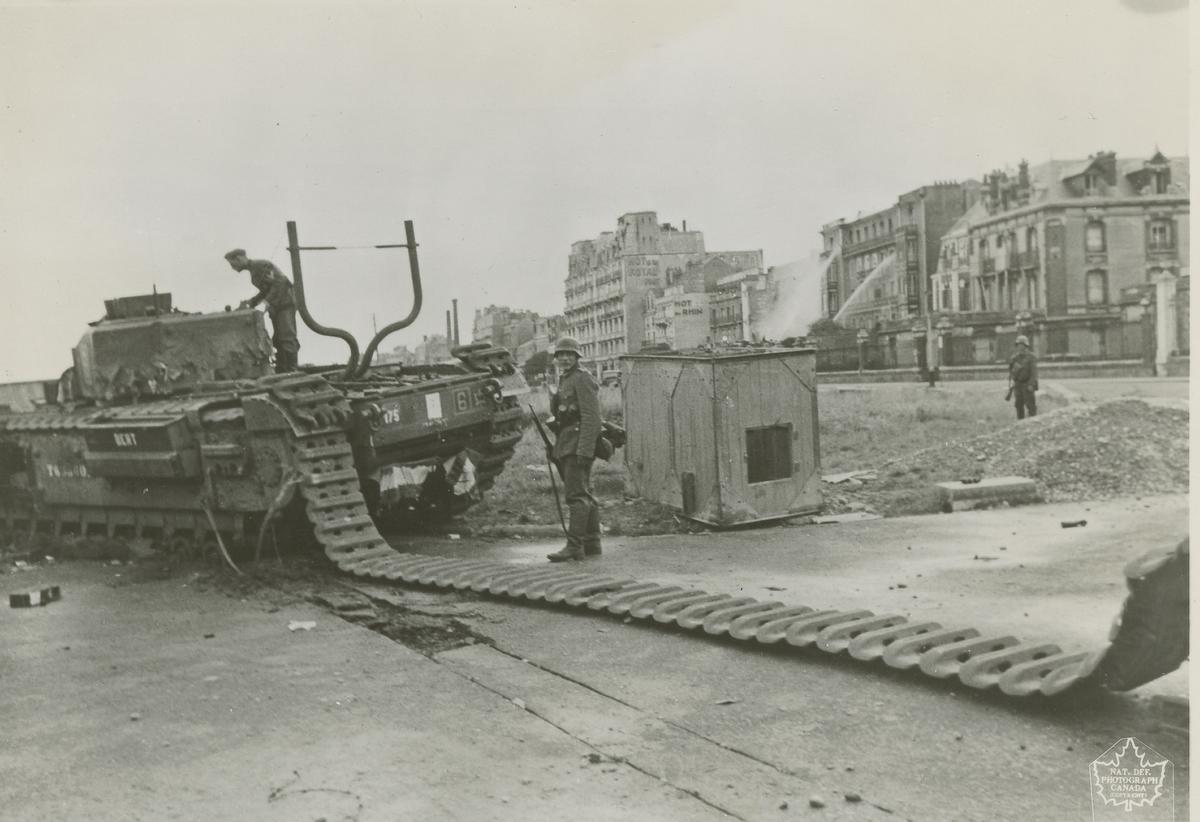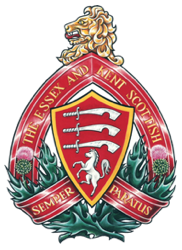CSM ‘Con’ Stapleton at The Dieppe Raid

German infantry inspects ruined Churchill tank, disabled on the promenade between the seawall and the town of Dieppe
Company Sargeant-Major Cornelius (Con) Stapleton was born in Goderich, Ontario in 1914. Growing up on the coast of Lake Huron, Stapleton was an experienced swimmer and accomplished athlete. He moved to Windsor from Toronto in 1938 and enlisted in the Essex Scottish Regiment (ESR) in 1939. In three years, Stapleton climbed the ranks from Private to Company Seargent-Major, the second highest non-commissioned officer (NCO) rank achievable. During his time in England, Stapleton gained a reputation as a tough non-commissioned officer who strictly enforced discipline in his sub-unit. During the lead-up to the Dieppe Raid, then known as Operation RUTTER (later Op JUBILEE), Stapleton was transferred to an NCO training center in Scotland. Due to this transfer, he was absent for most of the regiment’s specialized amphibious training. Despite his absence during training, Stapleton was entrusted with one of two “special platoons” organized to defend the unit’s headquarters during the raid. These special platoons were comprised of ten of the regimental support staff, such as cooks, drivers, and orderlies. Stapleton trained these men for two weeks prior to the raid to bring them up to par with the regular rifle platoons. Stapleton’s special platoon were put through rigorous exercises including: running, climbing cliffs, swimming, and tactical maneuvers. According to Stapleton’s 1979 CBC interview, this “Mottley Bunch” performed very well during training and of their ability he stated, “there was no question”.
Stapleton and his special platoon landed at Dieppe in the second wave, between Red and White Beaches. The platoon made their way across the beach, crossing the barbed wire obstacles and taking cover behind the seawall. Stapleton tried to locate Battalion Headquarters, but the fire and smoke obscured his vision. Stapleton assumed that if he could not find the HQ on the beachhead, his comrades must have already advanced into the city. Confident in his assumption, Stapleton ordered his men to dash across the Promenade during a lull in the enemy fire. Amazingly, the team made it across nearly unscathed. Only one man, Charlie Hoskin, was wounded. After crossing the Promenade, the team entered a hotel on the corner of Boulevard de Verdun. While inside, the nine men cleared the building room by room, killing two German infantrymen in the process. Stapleton could hear gunfire from all directions and noticed that it was being fired exclusively by German guns. Additionally, he noticed the windows of the hotel were still intact, indicating to him that the Allied artillery bombardment meant to level the buildings missed its mark. Using these clues, Stapleton correctly deduced that they were behind enemy lines, and his battalion was still stuck at the seawall. Despite this, Stapleton decided to press farther into the city.
His platoon began advancing up the narrow streets of Dieppe. They raced from cover to cover in small groups, each group guarding the next before moving themselves. In this fashion, they traversed the city inconspicuously until being spotted and fired upon by a machine gun nest. The team ran for the safety of nearby buildings and tended to the wounded once inside. One man received a bullet wound in the arm and was sent back to the beach for treatment. The team, now only eight men strong, began exploring the building they had occupied. They found French civilians in the basement hiding from the battle. They told the civilians to stay put and keep quiet before moving to the building’s third floor. From there, they observed a German tugboat docking along the harbor entrance. After firing several volleys from their Bren gun and rifles, the tugboat was disabled, and its crew scattered. After another fifteen minutes of watching, Stapleton doubled back down the road and continued deeper into the city. After moving several blocks, Stapleton saw an old French man leaning out of a second story window. The man was whispering in French and pointing towards the next street. Stapleton cautiously peeked around the corner and looked down the street. To his surprise, he saw a squad of German infantry loading onto a truck. He told his men to prepare their weapons for ambush and stay put. The platoon waited until the truck was full and driving towards them before opening fire. In “eight or ten good bursts of machine gun fire,” the truck was immobilized. Its driver was killed, along with the men in the back.
Stapleton and his platoon split into two groups, one on either side of the street. They continued together down the city blocks away from the ambushed truck in a “leapfrog” advance. After moving three blocks, a German sentry spotted the group opposite Stapleton and opened fire. Bullets landed above and around the men as they scrambled for cover. One man was struck in the eye by a fragment of stone chipped off by the burst of fire. The platoon again retreated into a nearby building. The wounded man was sent back to the beach. Stapleton and his platoon exited the building and moved in the opposite direction. The men advanced up a street parallel to the harbor until they encountered a maze of apartment buildings, alleys, and courtyards. The team took refuge in the lobby of an apartment building, and Stapleton began towards an alleyway to scout for enemies. A sniper’s bullet whizzed past his ear upon entering the alley, burning his face, and temporarily deafening him. Stapleton was pinned down; the alleyway was the platoon’s only escape route. He ordered his men to move through the building until they had an unobstructed view of the sniper’s building. In an act of extraordinary courage, Stapleton again stepped out into the alley to draw the sniper's fire. The moment he stepped back into cover, another bullet struck the road. That same moment, Stapleton charged forward. He fired his submachine gun at the sniper’s building while a man from the platoon threw a grenade into the sniper’s window.
With their exit secured, Stapleton decided that the platoon was spread thin and in danger of missing the scheduled evacuation time. They retreated towards the beach without any serious impediments, though another man was wounded. The team crawled back through the hotel they had first entered and made a second dash across the Promenade before returning to the seawall. They finally contacted the Battalion HQ and reported their actions to Lieutenant-Colonel Fred Jasperson, who radioed the news back to command vessels floating in the English Channel. Company Seargent-Major Stapleton and his special platoon spent four hours behind enemy lines and made the farthest advances of any assault unit that landed at Dieppe. Stapleton's team disabled two vehicles, killed twelve German infantry, and one sniper. They took only four casualties, all wounded. The platoon spent the remainder of the raid trapped at the seawall with the rest of the ESR. After several unsuccessful evacuation attempts and a dwindling supply of ammunition, they were forced to wait to be captured. Stapleton and his team were taken prisoner and sent to Stalag VIII B Prisoner of War camp where they spent the remainder of the war.
For his high level of bravery and leadership CSM Stapleton was awarded a Distinguished Conduct Medal.
Story by Calvin Barrett, Canada Summer Jobs 2022 participant
with The Essex and Kent Scottish Regiment Association
Sources
- DND Directorate of History 1939 Stapleton, C. (CSM.)
- Duty Nobly Done, The History of The Essex and Kent Scottish Regiment by Sandy Antal and Kevin R. Shackleton, 2006 – Chapter 11
